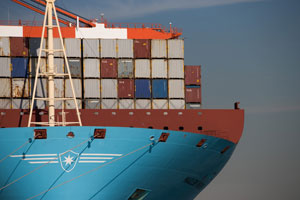Labor Dispute at West Coast Ports Contributes to Trade Deficit Shrinking to Five-Year Low

The trade deficit in the U.S. shrank in February to the lowest level in more than five years as a labor dispute at West Coast ports contributed to the weakest reading on purchases from abroad since 2011.
The gap, which measures the difference in the value between imports and exports, narrowed by $7.2 billion to $35.4 billion, lower than the lowest forecast of economists surveyed by Bloomberg News and the smallest since October 2009, the Commerce Department reported April 2 in Washington. Imports contracted 4.4%, the biggest slump since February 2009, when the economy was still in the recession.
The logjam of ships waiting to unload foreign-made goods at West Coast ports will soon dissipate as the worker dispute has been resolved, which means that imports will probably again flood into the U.S. Meanwhile, a strong dollar, which makes American-made goods more expensive to customers overseas, means exports will remain muted, causing the deficit to swell.
“You’re still dealing with West Coast port strikes,” Tom Porcelli, chief U.S. economist at RBC Capital Markets in New York, said before the report. “The port activity will skew the numbers towards one of improvement from a trade perspective. That will be temporary because now with the port strike resolved, you’ll get back to a more normal, steady state.”
The median forecast in a Bloomberg survey of 70 economists projected a trade gap of $41.2 billion. Estimates ranged from $38 billion to $44.8 billion. The Commerce Department revised the January shortfall to $42.7 billion from an initially reported a $41.8 billion.
Another report released at the same time showed jobless claims unexpectedly slumped. Applications for unemployment benefits decreased by 20,000 to 268,000 in the period ended March 28, a two-month low, the Labor Department reported. The reading was the second lowest in at least a year.
Imports declined to $221.7 billion in February, the least since April 2011, from $231.9 billion in January, the Commerce Department’s report showed. The drop was broad-based with decreases in fuel, autos, capital and consumer goods. Imports from Japan were the weakest since May 2011, signaling the West Coast port stoppage probably played a role.
America’s growing energy independence also had an impact, with purchases of foreign petroleum declining to the lowest level since 2004. The difference between imports and exports of the fuel shrank to $8.1 billion, the smallest since July 2002.
An appreciating dollar and slower growth overseas, combined with the port slowdown, probably played a restraining U.S. sales overseas.
Exports decreased 1.6% to $186.2 billion in February, the weakest since October 2012. The drop in shipments overseas was also broad based.
A report April 1 showed manufacturing in the U.S. expanded in March at the slowest pace in almost two years, as a stronger dollar, plunge in oil prices and lingering delays in shipments from West Coast ports hurt orders. The Institute for Supply Management’s index declined to 51.5, the weakest since May 2013, from 52.9 a month earlier, the Tempe, according to the Arizona-based group’s data.
After eliminating the effects of price fluctuations, which generates the numbers used to calculate gross domestic product, the trade deficit narrow to $50.8 billion in February, the smallest since November, from $54.6 billion a month earlier.
The average so far this quarter is larger than in the last three months of 2014, indicating trade will again subtract from economic growth.
U.S. GDP increased at a 2.2% annualized pace in the fourth quarter after advancing at a 5% rate in the previous three months. A widening trade gap subtracted a percentage point from growth.




